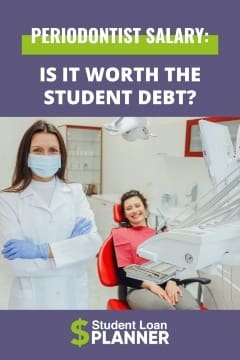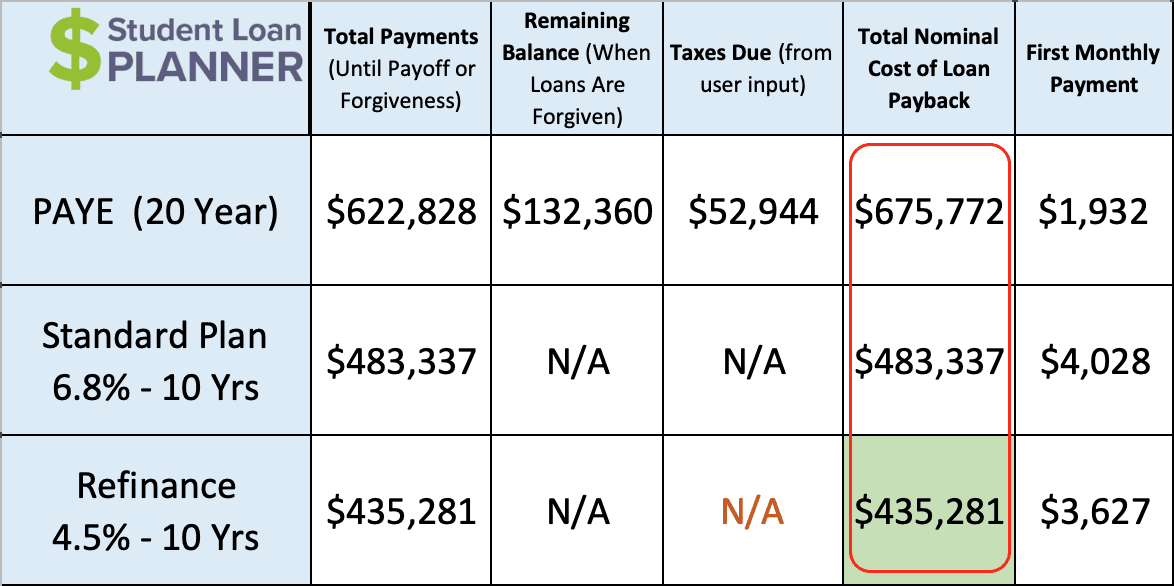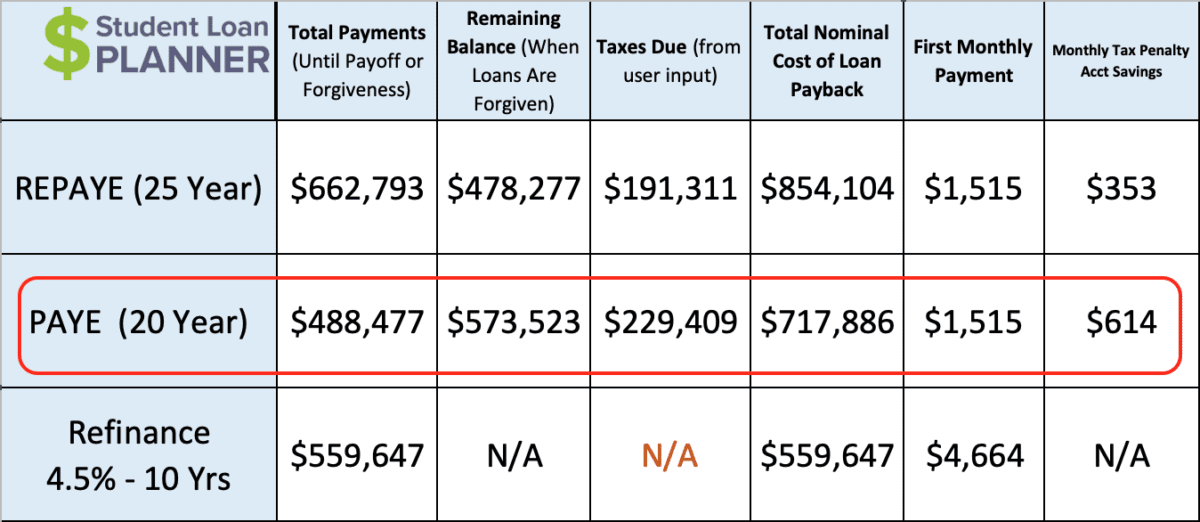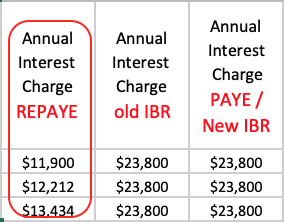
A periodontist is a dental specialty that primarily treats cases of severe or complex bone, jaw, or gum disease. They're also trained to place implants. Dentists can refer to periodontists for tough cases that go beyond the expertise of general dentistry.
Since they’re specialists, periodontists require extra training and can typically earn more money than a general dentist. But they tend to graduate with about the same amount of student loans.
To know if it’s worth the extra debt to become a periodontist, we’re going to look at income potential, the cost of getting the degree and other key factors that affect loan repayment plans for this type of role.
I’ll also run you through some case studies on how to pay back dental school debt during periodontal residencies. Let’s dive in!
Periodontist requirements can impact student loan repayment
Periodontists go to dental school just like general dentists. That means they'll typically need to earn a bachelor's degree first with strong grades in science courses (especially biology and chemistry) and math before passing the Dental Admission Test. Once accepted, most dental programs take four years to complete.
General dentists can start practicing right after graduating dental school. But periodontists go through three additional years of residency after graduation. Those three years give periodontists the extra skills they need to deal with more complicated diagnoses such as destructive diseases, disorders of the gums, and dental implants.
Resident salaries are a fraction of what is earned after becoming full-fledged periodontists. This can put a wrinkle in student loan repayment strategies. Therefore, the short-term repayment strategy while in residency may be different than the optimal long-term strategy for periodontists.
I’ll cover that in a little bit.
Income & Student Debt by Profession
How you compare to other
accountants stats*
| Average student debt | |
| Average income | |
| Average Debt-to-Income Ratio |
Statistics represent the population of Student Loan Planner clients in the respective profession referenced in the chart from 2017-2023. Sample excludes those in school or in training.*
Periodontist student loan debt — how much do people have?
Dental school is one of the most expensive grad-level programs out there. Dentists graduate with more debt than most other professions.
A typical dentist will graduate with around $250,000 to $300,000 in student loans. Those attending private schools can add about 50% more to that total. We’ve done hundreds of consults for dentists with an average debt of $381,000. That’s among the highest average we’ve consulted with compared to other professions.
However, dental schools continue to be in high demand because of the high-income potential for dentists and specialists like periodontists. Plus, periodontists an even higher income potential if they decide to open their own practice.
That being said, general dentists may overestimate their income. Many get paid well below their average expected salary. However, putting in the extra training during a periodontal residency leads to a higher income.

What is the average periodontist salary?
In a study published in 2022, the American Dental Association (ADA) examined the salary trends and job outlook for five different dental specialties: oral surgeons, endodontists, orthodontists, periodontists, and pediatric dentists. Unfortunately, it was determined that periodontists were the second lowest-paid of the five specialties analyzed.
Still, salary survey data has consistently shown that the periodontist occupations pay a nice premium compared to general dentists. According to ZipRecruiter employer job postings, the national average salary for dentists is $189,979 per year. The average Chief Dental Officer, meanwhile, makes $151,203 annually.
The same source shows that periodontists make an average base salary of $225,102. That’s a 20% premium on an already high general dentist salary.
Unfortunately, averages aren't always the most helpful when it comes to estimating your potential income. That's because the amount of money that you can make as a periodontist will depend on a variety of factors. Here are a few variables that could impact your periodontist salary the most.
Related: Protect Your Income with Disability Insurance for Periodontists: Costs and Coverage Decisions
Location
Where you live is an important factor that can significantly impact your periodontist salary. First, consider which state you'll want to work in. ZipRecruiter state salary estimates show that the average periodontist makes the highest salary in Oregon at $259,789 and the lowest salary in Florida at $155,776.
And here are 10 different locations where the average salaries fall between those two extremes:
- Alaska: $258,511
- North Dakota: $258,470
- Massachusetts: $255,385
- Hawaii: $253,011
- Washington: $247,198
- Nevada: $244,423
- South Dakota: $244,282
- Colorado: $241,219
- Rhode Island: $240,625
- New York: $229,283
- Delaware: $226,755
The number of periodontists in your city or town where they practice will also impact your income. We’ve found that periodontists who practice in more densely populated areas, like New York and Los Angeles, tend to make less money because of more competitive markets.
But the typical salary for those who set up in rural areas tends to be higher because they can be the only game in town. Less competition means more business, which leads to a higher income. Plus, you may be able to save even more money in these areas thanks to lower home prices, rental rates, property taxes, gasoline prices, and more.
Experience level
According to PayScale compensation data, the average entry-level periodontist salary is $154,356. Meanwhile, a mid-career periodontist with 5-9 years of experience earns $182,192 and an experienced periodontist (10-19 years of experience) earns $196,381 on average per year.
Practice ownership
Rarely have we worked with a practice-owning Doctor of Dental Surgery (DDS) or Doctor of Dental Medicine (DMD) earning less than $300,000. Profit margins from owning practices are higher than an associate’s payout. So a practice-owning periodontists make more money even if they have the same education as their non-practice owning colleagues.
If you want to hear more about what practice ownership entails, listen to this great podcast interview Travis had with Zachary Kingsberg, a practice-owning dentist. Though he’s a general dentist, it gives a good sense of what things could look like for periodontists.
The best two loan repayment strategies for periodontists
In our experience, periodontists have two solid options that will save the most money paying back their student loans:
- Pay off the loans aggressively with a goal of being debt free in 10 years or less. This could involve refinancing student loans to lower interest rates, as long as they could afford the payment.
- Sign up for an income-driven repayment (IDR) plan, like Pay As You Earn (PAYE) or Revised Pay As You Earn (REPAYE), that adjusts payments based on your income for 20-25 years. After that, loans are forgiven and taxes are owed on the forgiven balance.
With the first option, a periodontist should throw every extra dollar they can find at their debt to become debt free as quickly as possible. The second option is the exact opposite, pick an income-driven repayment plan that will keep payments as low as possible, max out pre-tax retirement accounts to lower adjusted gross income (AGI), save up for the tax bomb and maximize forgiveness.
Going with an in-between repayment strategy like (1) paying more while on income-driven repayment or (2) going beyond 10 years to pay back the debt after refinancing could be a needless waste of thousands of dollars. We’d rather periodontists keep that money in their pockets!
Which option is best? It depends on specific situations. There could also be a slightly different strategy while in residency. I’ll walk you through some scenarios.
When periodontists should refinance student loans
Julia has $350,000 at 6.8% in student debt and makes $250,000 as a periodontist. Her income is projected to grow slow and steady at 3% per year. Should she take the aggressive approach or go on income-driven repayment?
Let’s take a look at the numbers comparing PAYE, a standard 10-year plan and refinancing:

This is a clear refinancing case because it will save Julia the most money by far when compared to the other two options.
PAYE would cost about $240,000 more to pay back her student debt and double the amount of time until she’s student debt free (20 years versus 10 years). The refi payments are $1,700 higher per month versus her initial PAYE payment, but she can easily afford that on a $250,000 income. It’s worth it due to the long-term savings.
Refinancing is much better than the standard 10-year plan because of interest savings. Both get her debt free in 10 years, but lowering her interest rate from 6.8% down to 4.5% will reduce the total cost of paying back her debt by nearly $50,000 and lower her monthly payment by about $401 per month!
When periodontists should look at income-driven repayment
Andy is a periodontist who lives in Southern California. His salary is $200,000, and he owes $450,000 in student debt from undergrad and dental school. He’s not planning to open his own practice so his income should grow at the normal 3% per year.

Although it looks like refinancing provides the lower cost, it isn’t actually the most affordable option because the combination of his high payment and lower salary doesn’t leave much room for other financial goals.
Let’s say his take-home pay is about $10,000 per month. Nearly half would go toward his refi payments over the next 10 years. This leaves him with just over $5,000 for regular monthly outflows while living in expensive SoCal.
PAYE vs. student loan refinancing
On PAYE, his payment would start at $1,515 which would leave him with about $8,500 per month in take-home pay. He could save about $3,000 a month by maxing out his pre-tax retirement plan, saving for the tax bomb ($614/month) by doing a backdoor Roth IRA contribution and reaching other financial milestones along the way.
Assuming his $3,000 per month would be invested and grow at 5% per year, he’d build up a $465,000 nest egg in 10 years. That would continue growing to $1,004,000 in 20 years, even after paying the tax bomb. That doesn’t take into consideration that he could also increase the amount going to savings as his income grows.
Now, let’s say he were to refinance, throwing all he can toward his loans and holding off on savings for 10 years. He’d be debt free in 10 years. He could then take the $4,664 payment and invest it for the next 10 years (years 11-20) and end up with $724,000.
That isn’t bad but it ends up being about $280,000 shy of the PAYE plan which invests the difference in payment. Andy would have a 38% higher net worth after 20 years by being on the PAYE plan ($1,004,000 with PAYE versus $724,000 refinancing)!
Periodontists can save money on their student loans in residency
Let’s go back to Julia. Remember that she has $350,000 in student loans at 6.8%. Now, let’s assume that this is what she graduated with before entering her three-year residency.
Julia will earn $50,000 for three years as a resident, then she jumps to $250,000 after those three years.
Refinancing is still the long term play for her, but a $3,600 per month payment while earning $50,000 is an absolute no-go. That would pretty much be all of her take-home pay, if not more. Putting her loans in forbearance isn’t a good strategy either because the interest will skyrocket over those two years.
There is a way to keep the loan from growing fast even without making payments that actually cover all the interest. Enter the REPAYE interest subsidy.
Benefits of joining the REPAYE plan during residency
The normal interest charge on Julia’s loans would be $23,800 per year ($350,000 x 6.8%) no matter if she’s on PAYE or IBR. But REPAYE is different. The government will wipe away half of whatever interest isn’t covered by her monthly payment.
For example, let’s say Julia waives the grace period and starts on REPAYE between graduating from dental school and starting her periodontal residency. Her payments on REPAYE could actually be $0 per month for the first year of residency. The interest subsidy will put her in a better position versus going into forbearance with a $0 payment.
Since her $0 payments don’t cover any interest, the REPAYE interest subsidy wipes away half of the $23,800 interest charge. On PAYE, IBR, or if her payment was in forbearance, her loan would accrue $23,800 in interest with $0 monthly payments. But on REPAYE, the accrued interest grows by $11,900, which is half of the amount.

Using her tax returns as proof of income will also make things more affordable in residency. Her tax return for the year she starts her residency will show only $25,000, for half a year of residency salary, so her payments would be about $52 per month. From there, she’d get an $11,600 subsidy.
What should periodontists do after residency?
After three years of this strategy, Julia’s payments would be a total of about $1,500 and the government would have paid $35,000 in interest which works out to about $1,000 per month! After finishing up residency, her salary would be high enough that she can refinance her dental school loans and pay them back in 10 years or less.
Going on REPAYE would save her more than $35,000 in interest and even more when paying back her refinanced loans. REPAYE first, followed by refi, is a huge savings!
Is the periodontist salary worth the student debt?
The answer is an emphatic yes! Periodontists generally have strong incomes and career options. Ideally, minimizing student loans is the way to go, but that’s not always an option.
It’s scary to think about taking out $300,000 to $400,000 of student loans, but there’s an optimal plan to pay it back — whether you’re in Julia’s situation (refinancing) or in Andy’s situation (using the PAYE plan with aggressive savings on the side).
Though things will be tight during residency, the average salary for a periodontist is $80,000 more per year than general dentists. That means it takes less than three years to recoup the salary lost during those two years of residency. It’s all gravy after that.
Becoming a practice owner can make this even more compelling per the podcast episode I mentioned earlier.
Periodontists can have a solid student loan plan
You can find a clear path to pay back your student loans on a periodontist salary. A path that can not only save them significantly more during repayment but give them actions steps and a clear path to get it done.
Student Loan Planner® has done over 5,800 student loan consults for clients totaling over $1.4 billion of student loan debt. We can help you figure out the optimal path in just one hour. Plus we also include email support after the consult where we continue to answer questions and help you implement your plan. Learn more about our consult process here.
If your case is a pretty clear cut refinancing example with no practice ownership in the imminent future (perhaps because the refi payment could get in the way of the practice loan), there’s no need to get a consult. But I'd suggest applying through our cash back refinancing links to see if you can cut your interest rate and get the most affordable terms for your situation.
Income & Student Debt by Profession
How you compare to other
accountants stats*
| Average student debt | |
| Average income | |
| Average Debt-to-Income Ratio |
Statistics represent the population of Student Loan Planner clients in the respective profession referenced in the chart from 2017-2023. Sample excludes those in school or in training.*

What advice to you have for a resident that will be considered a student and employee? I am starting my first year of perio residency and the tuition is about $20,000 per year. I have to pay this up front so I am taking out student loans to cover the cost of tuition. I am paid however, a stipend of $20,000 per year. Is there a way to go into an income based repayment being that my income is so little? In order to have the government subsidize some of the interest? Or since I am taking out federal loans am I stuck in an active borrowing state? Would it be smarter to take out a private loan and start repayment on my federal loans? Thanks!
Hey Therin! Here is what our consultant Meagan has to say: Might be a better question for the financial aid office &/or the Dept of Ed’s Student Loan Support Center at 1-800-55707394 to confirm if you could enter repayment on their existing loans now, or if the federal loans borrowed for residency will trigger “in-school deferment” for the graduate + residency loans preventing them from being able to enter repayment. If you can, no income is too low for being eligible for an IDR plan, even 20k/yr.